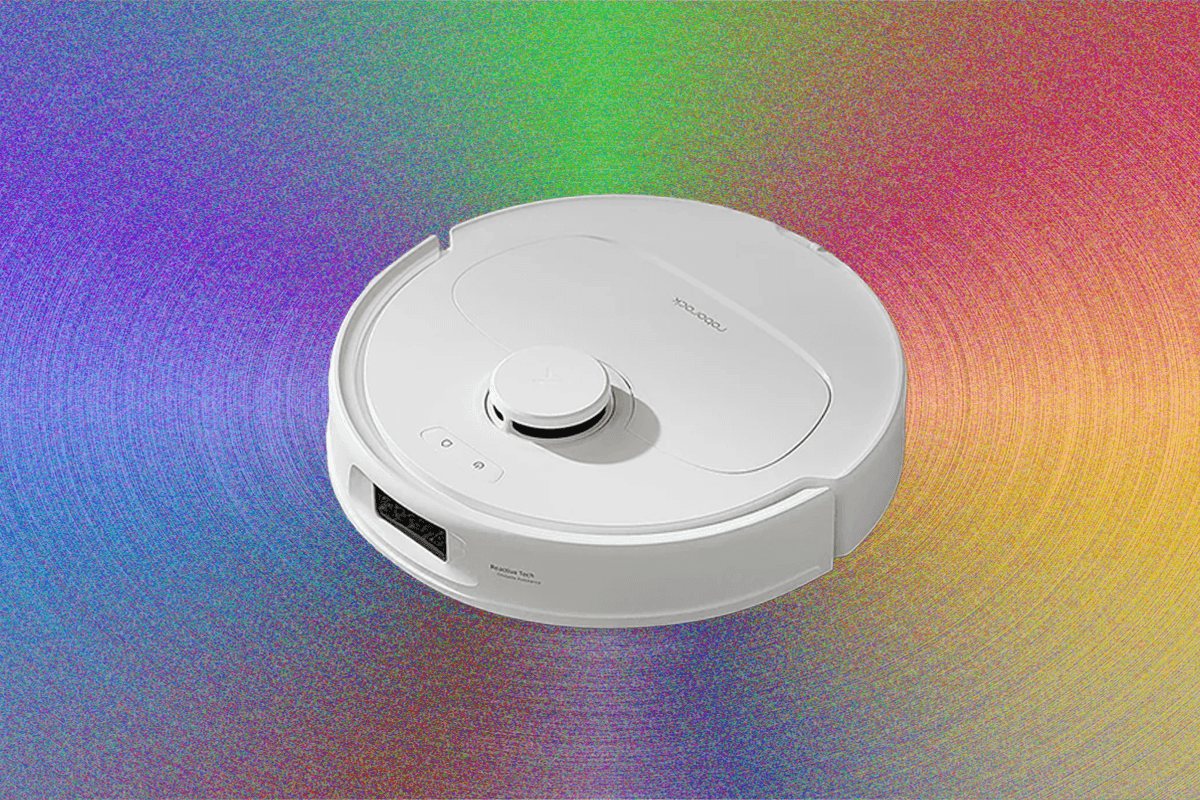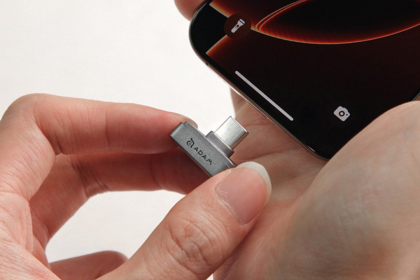Other Robot Vacuums to ConsiderPhotograph: Adrienne So
We are approaching the great robot vacuum convergence. At whatever price you want to pay, you can find a robot vacuum that will look very similar and have similar features. Here are a few that also worked well for us.
Roborock Qrevo Curv for $1,099: This was Roborock’s 2024 flagship vacuum, and it’s still great (reviewer Ryan Waniata calls it the best robot vacuum he’s ever used). It has slightly less suction power than this year’s Saros 10R, but I did use it to clean an entire carpet full of baking powder.
Eufy Mach S1 Pro for $1,300: This astoundingly beautiful robot vacuum will be the centerpiece of your kitchen. The water chamber is see-through and lights up, and an ozone generator purportedly removes up to 99.99 percent of bacteria. It also has ultra-precise navigation and a self-cleaning roller mop that washes itself as it cleans. However, it only has 8,000 Pa suction, which is less than some of our other picks, and at 26.4 inches high, the dock is very tall and makes storage difficult.
Eufy X10 Pro Omni for $550: Believe it or not, this is not a bad price for a hybrid robot vacuum mop (9/10, WIRED Recommends) with such fantastic navigational capabilities! (Sales have brought it even lower.) However, the Yeedi above is cheaper and offers mostly the same functionality.
Dreame L40 Ultra for $600: Dreame’s robot vacuum-mop combo debuted at IFA 2024. It’s a little cheaper than the Dreame X30 Ultra (7/10, WIRED Review), but it can’t do its coolest trick of removing the mop pads. WIRED reviewer Nena Farrell found that while it is cheaper, it is still not cheap, and it did bump into things a little more often than the X30. However, it is pretty and has plenty of battery life left after both mopping and vacuuming.
Avoid These Robot VacuumsNot every vacuum earns a spot on our list. These are the ones I repacked straightaway.
Mova P50 Pro Ultra Robot Vacuum for $799: This robot vacuum features a staggering 19,000 Pa of suction and a wide array of high-end features, like an extendable side brush and an intelligent dirt detection system. Reviewer Molly Higgins appreciated that it’s self-cleaning and that the bin auto-empties, but she found that, despite its smart systems, the mapping was not accurate, small obstacles often threw it off, and the vacuum eventually started avoiding rooms altogether.
Eufy E28 Combo Robot Vacuum for $1,000: I was super disappointed by this, since I have two dogs and two kids and frequently need to use a deep carpet cleaner, in addition to a mop and vacuum. This vacuum can mop and has a detachable carpet cleaning station. Unfortunately, the water injection system is wonky. The robot vacuum has to be perfectly positioned to get injected with water from the tank (I often had to tap it into place with my foot), and every time I mopped, it leaked all over my kitchen floor. At least the carpet cleaner was effective.
iRobot Combo J7+ for $399: iRobot makes beautiful robot vacuums that I’ve liked for years, but the software experience on this one was poor when I tested it. Since then, the company has undergone many twists and turns and released a new line under a new CEO. We will update this roundup once we have tested the latest lineup.
Ecovacs Deebot T50 Max Pro Omni for $700: My tester could not make it back to the docking station. I have asked Ecovacs for another review sample and will update this once I have tested it.
TP-Link Tapo RV30C for $229: I like the simplicity of this robot vacuum, but you can’t find replacement bags for it anymore.
Eureka J20 and Eureka J15 Pro Ultra for $830: Eureka is a highly respected name in the vacuum field, and these robot vacuums are gorgeous and come with many bells and whistles. However, Eureka vacuums found the tiny lip between the hardwood floor of my kitchen to the carpet of the living room to be completely insurmountable, and the app also forgot the map every time it hit a minor obstacle. It was so annoying.
Proscenic M9 for £439: Reviewer Simon Hill reported that this robot vacuum is terrible. It misses a lot of spots, the chute becomes instantly clogged with hair, and it makes constant noises. Whenever it gets stuck, it tells you to call customer service. The only plus side is that it seems to be out of stock.
Narwal Freo X Ultra for $1,134: This is a beautiful vacuum with lots of features, including baseboard dusting. However, despite moving it from room to room to find better Wi-Fi, and switching from phone to phone to try different versions of the app, I was unable to connect it to the app and so could not use it. (I reached out to Narwal multiple times but could not fix it; we will update if I do find a fix in the future.)
Switchbot K10+ for $600: You can now accessorize this tiny robot vacuum with additional cleaning accessories, like a stick vacuum or air purifier. Unfortunately, the robot vacuum itself still is horrible. This is the only vacuum where I’ve ever experienced a pooptastrophe—where it dragged a dog poop all over my house. Reviewer Simon Hill also tried this robot vacuum and discovered that it’s suicidal. The roller gets clogged easily, it can’t find its way back to the dock, and it often hurls itself down the stairs.
Shark PowerDetect 2-in-1 for $650: This vacuum cleaned surprisingly well (5/10, WIRED Review). However, it doesn’t auto-empty, DirtDetect doesn’t work, and the app is completely bonkers (maps aren’t accurate, can’t add multiple floors, and cleaning times are off).
What Navigation System Do I Use?Robot vacuum manufacturers will try to tell you that the most important spec is the level of suction. That is wrong—it’s the navigation system. It doesn’t matter how good a vacuum is at cleaning if it gets stuck every time it starts. A more complicated or expensive navigation system doesn’t guarantee that it won’t get stuck, but it is a good starting point. Many vacuums also combine systems.
Sensor mapping: The most inexpensive vacuums use a combination of sensors along the exterior of the vacuum, like cliff detectors on the bottom and wall detectors on the bumper, to ping-pong around your home avoiding obstacles.
Gyroscope: This is an affordable but surprisingly effective method of mapping that has been used in ships for centuries. A spinning wheel or light helps the vacuum determine its position relative to other objects in your home.
Lidar: Lidar stands for “light detection and ranging.” The vacuum uses pulsed lasers to determine how far away each object is.
Camera navigation: There’s a camera on it. Basically, the vacuum has little eyes that look around. While I’ve found this system to be extremely accurate and/or unintentionally hilarious, you must look for additional security protocols to make sure that said hilarious images of your home don’t end up on the internet.
SLAM: With SLAM navigation, or “simultaneous localization and mapping,” the vacuum uses algorithms to process a bunch of data—for example, how many times the wheels have rotated, along with camera or sensor data—to calculate where and how far it should move. It’s usually used in combination with a few, or all, of these other navigation technologies.
IMU: An inertial measurement unit is a system that combines multiple sensors like gyroscopes and accelerometers to navigate by dead reckoning.
Machine learning: Many robot vacuum manufacturers now tout their own proprietary mapping system. For example, iRobot uses a system called Imprint Smart Mapping that learns as it cleans, as does Roborock’s SmartPlan. These also usually come in combination with a camera or lasers.
Robot Vacuum TipsRobot vacuums have a complicated task. Your home is ever-changing, and no robot vacuum will be perfect. We have a few starting points here, but if you’re still having trouble, you should check out our guide to getting the most into your robot vacuum.
Do robot vacuums work on hardwood? Yes. Many robot vacuums have different cleaning modes that will allow you to select between carpeting, tile, or other floor surfaces. If you have a combination mop-vacuum, only use the brand’s recommended liquid cleaner. Using a generic cleaner may clog your docking station.
Will my pet hate my robot vacuum? Maybe. I’ve introduced three dogs to robot vacuums with minimal problems, but if you’re nervous, you can try giving your pets treats when you turn the vacuum on for the first few times.
Stay home for your robot vacuum’s first few runs. Many homes have hot spots—a weird door jamb, a lumpy rug—where you will need to rescue your vac. Do a quick run-through beforehand for robot booby traps, like ribbons, charging cables, and pieces of string.
Check your Wi-Fi. If you have a Wi-Fi-enabled robot vacuum, most of them can only connect to the 2.4-GHz wireless band. If you’re having problems connecting, make sure you’re linking to the right band. Check out our guide to setting up your smart home for more tips.
Vacs need maintenance. Like every robot—especially one that comes in contact with the grimiest parts of your house—you need to care for it regularly. Error messages may prompt you to empty the bin mid-run, cut the hair off the rollers, or wipe off the cliff sensors. Instruction manuals and YouTube can help.
Vacuum during the day. If you have the choice, it’s usually better to schedule a run at 2 pm than at midnight, since many vacuums also use optical sensors to navigate.
Don’t throw out your hand vacuum. I hate to be a downer, but you’re probably still going to need a full-size manual vacuum once in a while. I keep a Dyson around for quick spot cleaning and vacuuming bedroom corners.
Be wary about disposable bags: Some vacuums pull dust into a disposable bag. Instead of dumping out the bin and getting dust everywhere, you just toss the bag out neatly and replace it. Unfortunately, some companies stop selling these bags altogether (looking at you, TP-Link), leaving you with a functioning robot vacuum that can’t suck up dust anywhere. Try and find information on how long parts like this will be available.
How We TestI’ve been personally reviewing robot vacuums since 2017 and have tested well more than 100 (I have not tracked the exact number but I have reviewed one roughly every two weeks for eight years). Each WIRED gear tester sets up the vacuum in their own home, according to the manufacturer’s instructions, and in a spot with clear Wi-Fi signal. Over the course of at least two weeks, we run the vacuum every day, examining a number of factors: battery life; how well the app works; whether the map is accurate; if it consistently cleans around the edges of your home; and how well it picks up dirt of various sizes, which includes sand, lint, dog hair, Cheerios, wood chips, and flour.
We also look for mitigating factors, such as whether it’s incredibly loud or ugly, or if it fits into your kitchen at all. For a vacuum to be useful, you have to want to use it and have it around. We also noted a vacuum’s power via the manufacturer’s stated Pa, or pascals—the higher the number, the greater the suction.
Power up with unlimited access to WIRED. Get best-in-class reporting that’s too important to ignore for just $1 per month for 1 year. Includes unlimited digital access and exclusive subscriber-only content. Subscribe Today.












